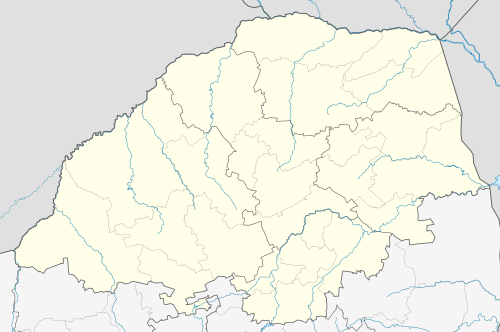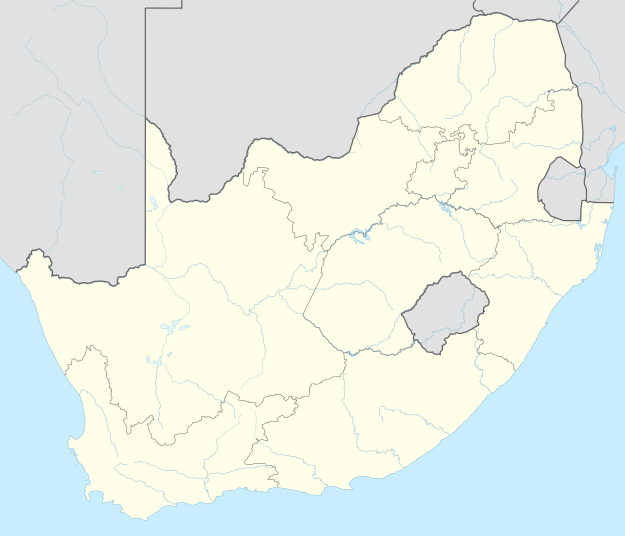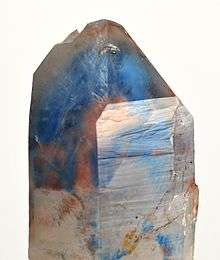Musina
Musina (formerly Messina) is the northernmost town in the Limpopo province of South Africa. It is located near the confluence of the Limpopo River with the Sand River and the border to Zimbabwe. It has a population of between 20,000 and 40,000. Iron ore, coal, magnetite, graphite, asbestos, diamonds, semi-precious stones and copper are mined in the region.
Musina Messina | |
|---|---|
 Musina  Musina | |
| Coordinates: 22°20′17″S 30°02′30″E | |
| Country | South Africa |
| Province | Limpopo |
| District | Vhembe |
| Municipality | Musina |
| Established | 1904 |
| Area | |
| • Total | 109.38 km2 (42.23 sq mi) |
| Population (2011)[1] | |
| • Total | 42,678 |
| • Density | 390/km2 (1,000/sq mi) |
| Racial makeup (2011) | |
| • Black African | 93.3% |
| • Coloured | 0.4% |
| • Indian/Asian | 0.7% |
| • White | 5.1% |
| • Other | 0.5% |
| First languages (2011) | |
| • Venda | 48.8% |
| • Sotho | 11.7% |
| • Northern Sotho | 10.4% |
| • English | 5.4% |
| • Other | 23.7% |
| Time zone | UTC+2 (SAST) |
| Postal code (street) | 0900 |
| PO box | 0900 |
| Area code | 015 |
| Website | www |
History

After serving in the Anglo-Boer War, Colonel John Pascoe "J.P." Grenfell (1866-1948), grandson of John Pascoe Grenfell and brother of Francis Octavius Grenfell, came to South Africa after hearing rumors of valuable copper being in the area.[2][3] Two prospectors, James Harper and James Campbell, told Grenfell that there were copper deposits, south of the Limpopo River, where the local tribe discovered them.[2] Apparently, the tribe had mined the copper, but the prospectors said their mining of it had ceased.
Grenfell went to the area and had the deposits inspected. After verifying that they were valuable, he purchased a farm, Berkenrode, near a planned mining site, in October 1903.[2] Five months later, he was granted a discoverer's certificate and, in that same month (March 1904), he founded the village Messina (later Musina).[2]
In January 1905, he founded, and chaired, the Messina (Transvaal) Development Company, which became one of the largest companies in South Africa.[2] Prior to becoming president of the United States, Herbert Hoover, served on the board of the company from 1914 to 1916.[4]
Geography
The Limpopo River is a dry river bank which flows annually in rains when lichen and other plant species of the desert region come alive. Sometimes, it floods. The low-shrub and thorny tree lands that surround Musina and thrive in rains are alive with animals in sanctuaries that offer experienced-only camping safari accessible by sand and rock road tracks. Access is generally good, with the N1 road from Johannesburg through Musina northwards being wide tar, as are most other roads in the area.
Border with Zimbabwe
The link with Zimbabwe at Beitbridge has become one of the busiest roads in the world and the busiest in Africa, due to black market importers from Zimbabwe and people looking for employment. This is mainly due to thousands crossing the border into South Africa every day. According to the New York Times, in January 2009 Musina had a shifting population of about 15,000 foreigners, overwhelmingly Zimbabweans, many of whom lived in a refugee camp at the showground or in the streets.
Name
"Musina" in Venda means spoiled. Alluding to the fact that copper "spoilt" the Venda's efforts to mine gold in the region, as they couldn't effectively separate the gold from the useless copper.
The spelling of "Messina" was changed, by the Limpopo Government, in 2003, to "Musina" in order to correct the colonial-era misspelling of the name of the Musina people.[5]
Climate
Musina experiences a hot semi-arid climate (Koppen: BSh) with hot temperatures most of the year. Average annual precipitation amounts to 372 mm (14.6 in), and is highly concentrated in the summer months from October to April when severe late-afternoon and evening thunderstorms are common. Winter is extremely dry, with almost no precipitation, typically recorded in the driest months from June to August. Clear skies and exceptionally low humidity at this time of the year enable temperatures to plunge close to freezing at night, although frost is fairly uncommon.
| Climate data for Musina, South Africa | |||||||||||||
|---|---|---|---|---|---|---|---|---|---|---|---|---|---|
| Month | Jan | Feb | Mar | Apr | May | Jun | Jul | Aug | Sep | Oct | Nov | Dec | Year |
| Average high °C (°F) | 33 (91) |
32 (90) |
31 (88) |
30 (86) |
28 (82) |
25 (77) |
25 (77) |
27 (81) |
29 (84) |
31 (88) |
32 (90) |
32 (90) |
30 (85) |
| Average low °C (°F) | 21 (70) |
21 (70) |
19 (66) |
16 (61) |
12 (54) |
8 (46) |
8 (46) |
10 (50) |
14 (57) |
17 (63) |
19 (66) |
20 (68) |
15 (60) |
| Average precipitation mm (inches) | 61 (2.4) |
65 (2.6) |
42 (1.7) |
26 (1.0) |
12 (0.5) |
4 (0.2) |
1 (0.0) |
2 (0.1) |
15 (0.6) |
33 (1.3) |
55 (2.2) |
56 (2.2) |
372 (14.6) |
| Average precipitation days | 8 | 8 | 5 | 4 | 2 | 2 | 2 | 1 | 3 | 5 | 7 | 9 | 55 |
| Source: World Climate Guide [6] | |||||||||||||
Schools
Primary schools
- Bonwa-Udi Primary School
- Beitbridge Primary School
- Gateway Primary School
- Laerskool Messina Primary
- Makushu Primary School
- Nehemiah Christian School
- Rixile Primary School
- St Martin De Porres Primary School
High schools
- Hoërskool Eric Louw
- Musina High School
- Renaissance Secondary School
References
- "Main Place Musina". Census 2011.
- "Grenfell, Colonel John Pascoe". Biographical Database of Southern African Science.
- Peter Old Field (31 July 2014). Victoria Crosses on the Western Front August 1914- April 1915: Mons to Hill 60. Pen and Sword. p. 221.
- "Ajoite". Mindat.
- "Limpopo changes town names". Brand South Africa. 10 June 2003.
- "Climate Statistics for Musina, South Africa". Retrieved 15 January 2012.
.svg.png)